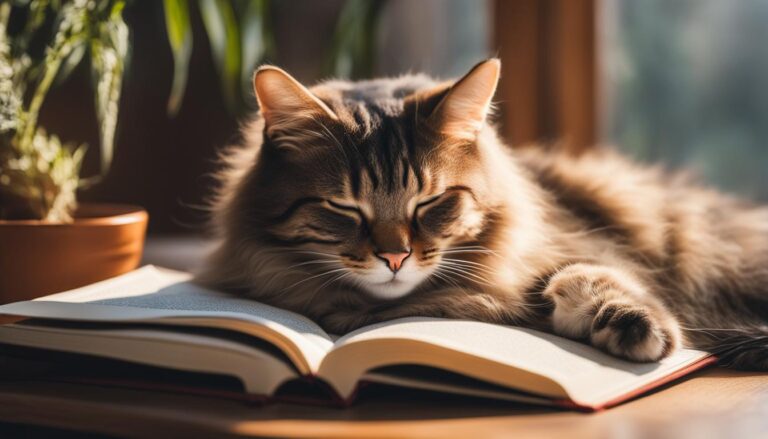Have you ever wondered why cats sleep so much? It’s no secret that our feline friends can spend hours upon hours snoozing away. In fact, adult cats sleep an average of 12 to 16 hours a day! Let’s dive into their intriguing sleep patterns and understand the reasons behind their excessive slumber.
主要收获
- Cats sleep so much due to their evolutionary roots as natural predators, conserving energy for hunting.
- They have a polyphasic sleep pattern, engaging in multiple shorter sleep periods throughout the day.
- Cats’ sleep cycle includes both light sleep and deep sleep stages, including REM sleep where they may dream.
- Cats are most active during dawn and dusk, known as crepuscular animals.
- Domestic cats may sleep even more due to their safe home environment and reduced need for constant vigilance.
The Evolutionary Roots of Cat Sleep
Cats’ excessive sleep can be traced back to their evolutionary history as hunters. Their ancestors relied on bursts of energy for hunting and needed plenty of rest to conserve energy for successful hunts. Through evolution, cats developed a sleep pattern that combines short periods of intense activity with long stretches of rest. They have different sleep cycles, including REM sleep and deep sleep stages, which contribute to their overall well-being. Deep sleep allows their bodies to repair and regenerate tissues, while REM sleep may be associated with dreams about their adventures and hunting experiences.
了解 sleeping habits of cats is essential to comprehend their unique needs. Cats are known for taking frequent naps throughout the day, which is a result of their evolutionary roots. These feline creatures have a polyphasic sleep pattern, meaning they alternate between periods of sleep and wakefulness. This sleep pattern helps them conserve energy, as they were originally hunters in the wild who needed to preserve their strength for hunting prey.
“Cats’ excessive sleep can be traced back to their evolutionary history as hunters.”
During their sleeping periods, cats go through different stages of sleep, including light sleep, deep sleep, and rapid eye movement (REM) sleep. Light sleep allows them to quickly respond to any potential dangers, while deep sleep is essential for their physical and mental restoration. REM sleep, characterized by rapid eye movements and brain activity, may be associated with dreaming in cats. These sleep stages are crucial for their overall health and well-being.
| Sleep Cycle | 说明 |
|---|---|
| Light Sleep | Allows cats to quickly respond to potential dangers. |
| Deep Sleep | Essential for physical and mental restoration. |
| REM Sleep | Associated with dreaming in cats. |
By understanding the evolutionary roots and sleep cycles of cats, we can better appreciate their need for sleep and provide them with a comfortable environment for rest. Cats’ sleeping habits are a testament to their survival instincts and remind us of the importance of balance in our own lives. Just like cats, we should prioritize rest and rejuvenation to maintain a healthy lifestyle.
The Influence of Circadian Rhythms and Adaptation
Cats have a unique sleep pattern that is influenced by their circadian rhythms and adaptation to their environment. Understanding these factors is essential for ensuring their well-being and avoiding sleep deprivation risks.
Hunting Instincts and Active Phases
Cats are crepuscular animals, meaning they are most active during dawn and dusk. This behavior is rooted in their hunting instincts, as these are the times when their prey is most active. To prepare for these active phases, cats have adapted their sleep patterns. They engage in extended periods of rest during the day, allowing them to conserve energy and be ready for their active hunting periods.
“Cats have an innate ability to adapt their sleep patterns to their environment, and disrupting this can have negative effects on their health.”
The Importance of Sleep Duration
Understanding the duration of a cat’s sleep is crucial for providing them with the care they need. Cats generally require around 12 to 16 hours of sleep per day. This allows them to physically and mentally rejuvenate, repair tissues, and process information from their surroundings. Sleep deprivation can lead to various health risks, including decreased immune function and cognitive impairment.
Creating a Sleep-Friendly Environment
To ensure a cat’s optimal sleep, it’s important to create a sleep-friendly environment. Providing a quiet and comfortable space where they can rest undisturbed is essential. Additionally, maintaining a consistent daily routine and avoiding disruptions to their sleep schedule helps cats maintain their natural circadian rhythms.
| Factors Influencing Cat Sleep | Impact |
|---|---|
| Hunting instincts and activity patterns | Adaptation to dawn and dusk hunting periods |
| Sleep duration | 12 to 16 hours per day |
| Sleep deprivation risks | Decreased immune function and cognitive impairment |
| Creating a sleep-friendly environment | Quiet, comfortable space and consistent routine |
By understanding the influence of circadian rhythms and adapting to a cat’s natural sleep patterns, we can ensure they receive the necessary rest they need to thrive. Creating a sleep-friendly environment and respecting their sleep duration are vital for their overall well-being.
Table: Comparing Cat Sleep Patterns in Different Environments
| Wild Cats | Domestic Cats |
|---|---|
| Constant vigilance required | Safe and consistent home environment |
| Shorter sleep periods due to hunting needs | Longer sleep periods due to reduced need for energy conservation |
| Alert and ready to react to predators | Relaxed and able to fully unwind |
In conclusion, the environment plays a significant role in shaping the sleep patterns of cats. Providing a safe and comfortable space for your feline companion ensures that they can enjoy the restorative benefits of a good night’s sleep. By understanding the impact of the environment on cat sleep, you can create an environment that supports their well-being and allows them to thrive.
A Lesson in Self-Care from Cats’ Sleeping Habits
As you observe your feline companion curled up in a cozy spot, indulging in a long nap, you may find yourself envious of their ability to prioritize rest. Cats’ sleeping habits can serve as a valuable lesson in self-care for humans. By following their lead, we can learn to find harmony and prioritize our own rest for optimal physical and mental well-being.
Cats prioritize balance by switching between intense activity and deep rest. Just like them, we humans need to pace ourselves and ensure we get adequate sleep. Studies have shown that sleep deprivation can have detrimental effects on our overall health, leading to increased stress, impaired cognitive function, and a weakened immune system.
“Sleep is essential to maintaining both physical and mental health. Just like cats, we need to prioritize rest to function at our best.” – Sleep Expert Dr. Sarah Richardson
Understanding a cat’s need for sleep can encourage us to reflect on our own sleeping habits. Are we getting enough sleep each night? Do we allow ourselves time for relaxation and rejuvenation? Cats’ love for sleep is deeply rooted in their evolutionary journey as hunters, and it serves as a reminder for us to prioritize our own rest as well.
Why Cat Sleep Deprivation Carries Risks
It is crucial to recognize the risks associated with cat sleep deprivation and, by extension, our own. Sleep deprivation in cats can lead to lethargy, irritability, and decreased cognitive function. Similarly, when we humans don’t get enough sleep, we may experience mood swings, difficulty concentrating, and an increased risk of accidents or injuries.
So, take a moment to learn from our feline friends and embrace their wisdom in balancing activity and rest. Prioritize your sleep, create a peaceful sleep environment, and allow yourself time to unwind and recharge. By adopting these self-care practices, you can lead a healthier and more fulfilled life, just like your beloved cat.
| 猫 | Humans | |
|---|---|---|
| Sleep Duration | 12-16 hours a day | 7-9 hours a night |
| Sleep Quality | Deep sleep stages and REM sleep | REM sleep and non-REM sleep cycles |
| Risk of Sleep Deprivation | Lethargy, irritability, decreased cognitive function | Mood swings, difficulty concentrating, increased risk of accidents or injuries |
结论
Cats’ excessive sleep is a natural behaviour rooted in their evolutionary history as hunters. Their sleep patterns, including both light and deep sleep stages, play a crucial role in their overall well-being. Cats are crepuscular animals, most active during dawn and dusk, and domesticated cats may sleep even more due to the safety and consistency of their home environment.
Understanding and respecting a cat’s need for sleep is essential. By providing them with a comfortable and peaceful space to rest, we can ensure their physical and mental health. Just like cats, humans can also benefit from prioritising rest and balance in their lives to lead healthier and more fulfilled lives.
So, next time you observe your cat indulging in a lengthy nap, remember that it is a natural behaviour, and they are simply getting the rest they need. By embracing their sleep patterns and providing them with the necessary care, you can ensure your feline friend’s well-being and strengthen the bond you share.




